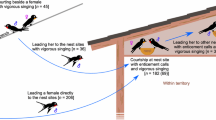Abstract
Studies of female mate preference in zebra finches (Taenopygia guttata) have shown that male beak colour and song rate are important. However, the two characters are correlated. Here the effect of beak colour and song rate on female choice are examined independently. In mate choice tests involving two males, beak colour was manipulated artificially using nail varnish. The results showed that females showed a significant preference for males with a high song rate, but not with a red beak. Females did not prefer males with a red beak if song rate was low and females preferred males with orange beaks who expressed a high song rate. Female preference for males with red beaks was not found when beak and song characters were no longer correlated.
Similar content being viewed by others
References
Birkhead TR, Pellat J, Hunter FM (1988) Extra-pair copulation and sperm competition in the zebra finch. Nature 334:60–62
Birkhead TR, Hunter FM, Pellat J (1989) Sperm competition in the zebra finch, Taenopygia guttata. Anim Behav 38:935–950
Bradbury J, Vehrencamp S, Gibson R (1985) Leks and the unanimity of female choice. In: Greenwood PJ, Harvey PH, Slatkin M (eds) Evolution, essays in honour of John Maynard Smith. Cambridge University Press, Cambridge
Burley N (1981) Mate choice by multiple criteria in a monogamous species. Am Nat 117:515–528
Burley N (1985) Leg-band colour and mortality patterns in captive breeding populations of zebra finches. Auk 102:647–651
Burley N (1986a) Sex-ratio manipulation in colour banded populations of zebra finches. Evolution 406:1191–1206
Burley N (1986b) Sexual selection for aesthetic traits in a species with biparental care. Am Nat 127:415–445
Burley N (1988) The differential allocation hypothesis: an experimental test. Am Nat 132:611–628
Burley N, Coopersmith CB (1987) Bill colour preferences of zebra finches. Ethology 76:133–151
Burley N, Krantzberg G, Radman P (1982) Influence of colour banding on the conspecific preferences of zebra finches. Anim Behav 30:444–455
Clayton NS (1988) Song learning and mate choice in estrildid finches raised by two species. Anim Behav 36:1580–1600
Clayton NS (1990) Mate choice and pair formation in Timor and Australian mainland zebra finches. Anim Behav 39:474–480
Hoezler GA (1989) The good parent process of sexual selection. Anim Behav 38:1067–1078
Houtman AM (1990) Sexual selection in the zebra finch, Poephila guttata. DPhil thesis, University of Oxford
Houtman AM (1992) Female zebra finches choose extra-pair copulations with genetically attractive males. Proc R Soc B 248: 3–6
Immelmann K (1959) Experimentelle Untersuchungen ueber die biologische Bedeutung artspezifischer Merkmale beim Zebrafinken (Taenopygia eastanotis Rom). Zool J Syst 86:437–592
Immelmann K (1962) Beitraege zur vergleichenden Biologie australischer Prachtfinken. Sperm Syst 90:1–196
Morris D (1954) The reproductive behaviour of the zebra finch (Poephila guttata) with special reference to the pseudofemale behaviour and displacement activities. Behaviour 6:271–322
Pomiankowski AN (1988) The evolution of female mate preferences for male genetic quality. Oxford Surv Evol Biol 5:136–184
Ratcliffe LM, Boag PT (1987) Effects of colour bands on male competition and sexual attractiveness in zebra finches (Taenopygia guttata). Can J Zool 65:333–338
Reid ML, Weatherhead PJ (1990) Mate choice in Ipswich sparrows: the of variability. Anim Behav 40:538–544
Rice WR (1989) Analysing tables of statistical tests. Evolution 43:223–225
Sonneman P, Sjolander S (1977) Effects of cross-fostering-on the sexual of the female zebra finch, Taenopygia guttata. Z Tierpsychol 45:337–348
Ten Cate C (1984) Behavioural differences between zebra finch and Bengalese finch (foster) parents raising zebra finch offspring. Behaviour 81:152–172
Ten Cate C, Mug G (1984) The development of mate choice in zebra finch females. Behaviour 90:125–150
Zahavi A (1975) Mate selection — a selection for a handicap. J Theor Biol 53:205–214
Author information
Authors and Affiliations
Rights and permissions
About this article
Cite this article
Collins, S.A., Hubbard, C. & Houtman, A.M. Female mate choice in the zebra finch — the effect of male beak colour and male song. Behav Ecol Sociobiol 35, 21–25 (1994). https://doi.org/10.1007/BF00167055
Received:
Accepted:
Issue Date:
DOI: https://doi.org/10.1007/BF00167055




